中考英语语法考点总结——状语从句(共33张PPT)
文档属性
| 名称 | 中考英语语法考点总结——状语从句(共33张PPT) |  | |
| 格式 | ppt | ||
| 文件大小 | 4.0MB | ||
| 资源类型 | 试卷 | ||
| 版本资源 | 通用版 | ||
| 科目 | 英语 | ||
| 更新时间 | 2022-04-10 18:57:31 | ||
图片预览

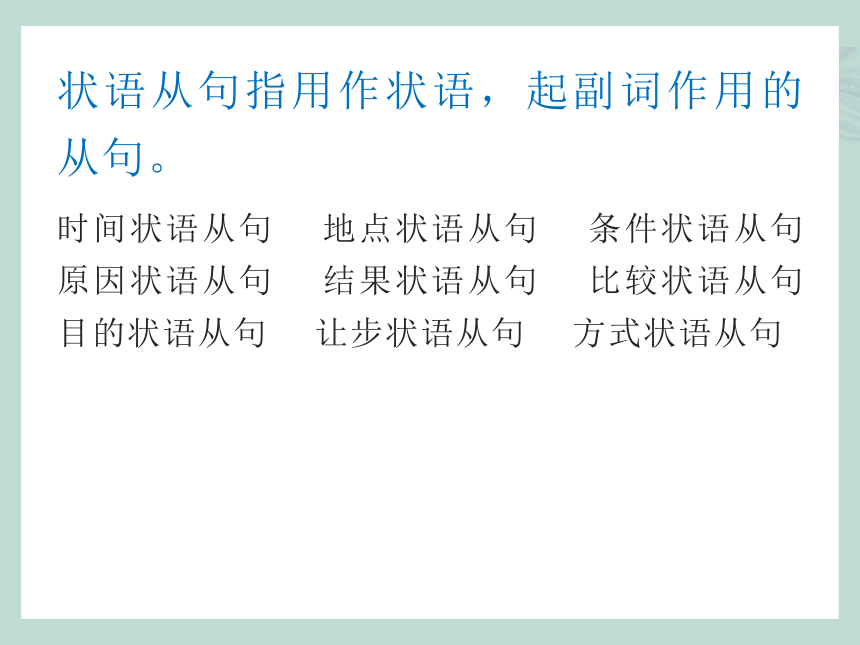
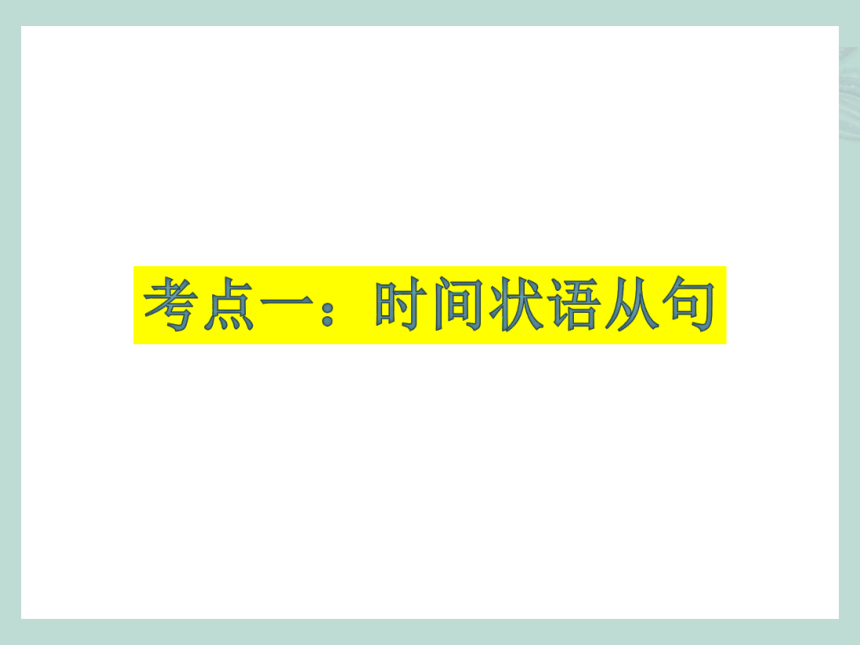

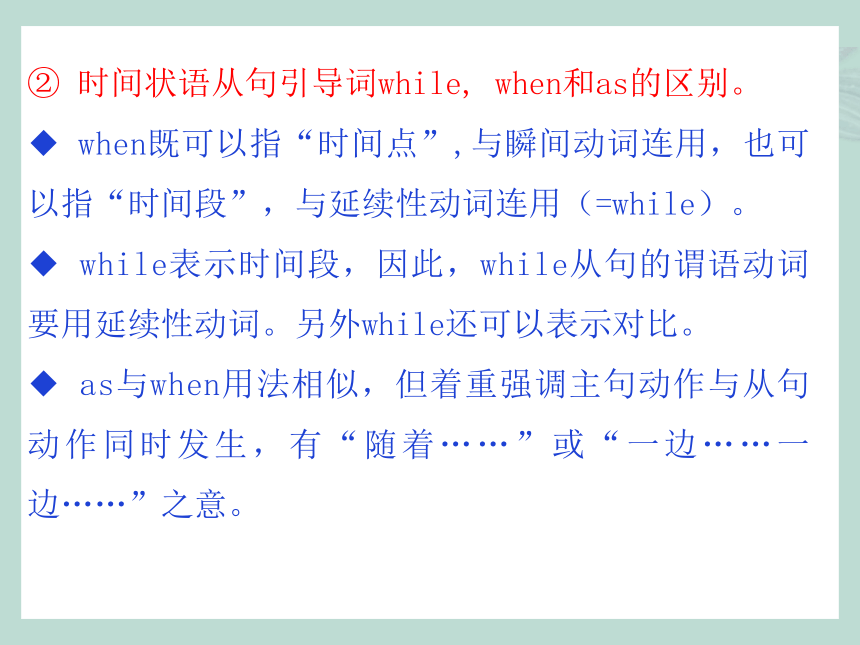
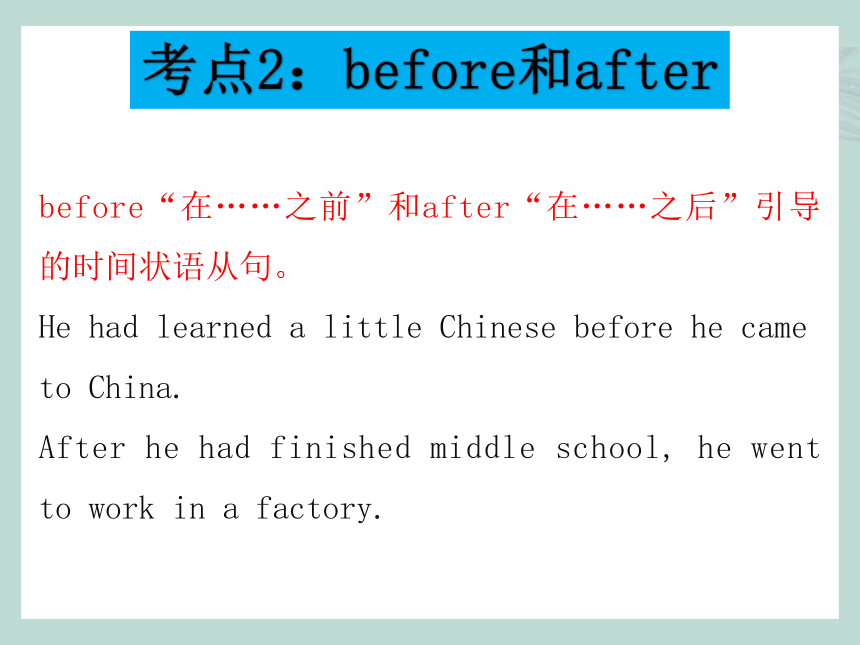
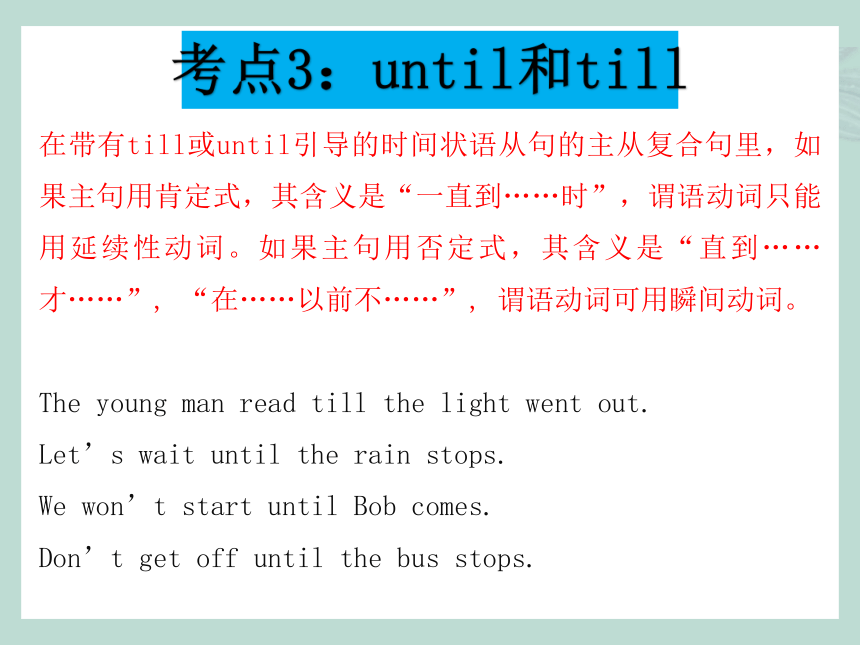
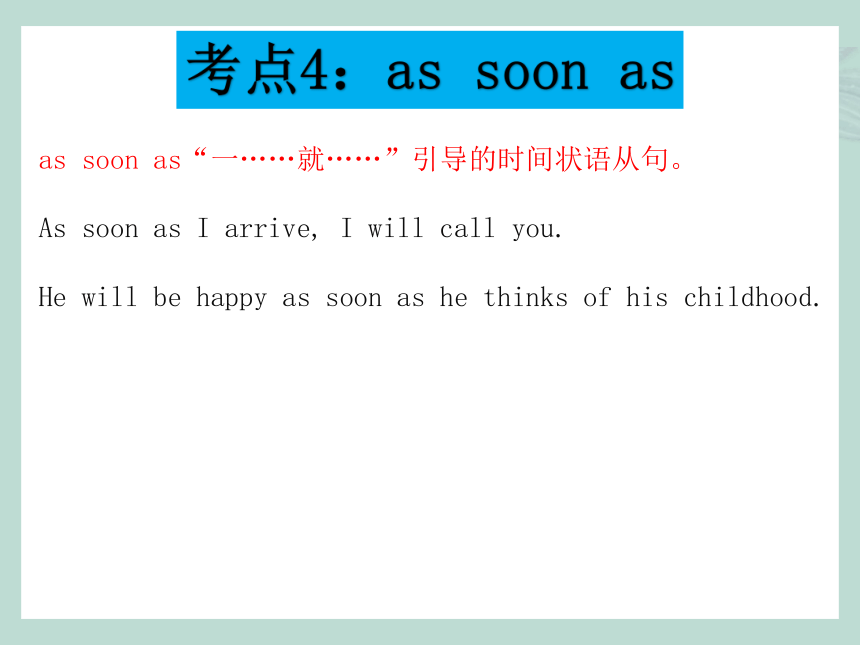
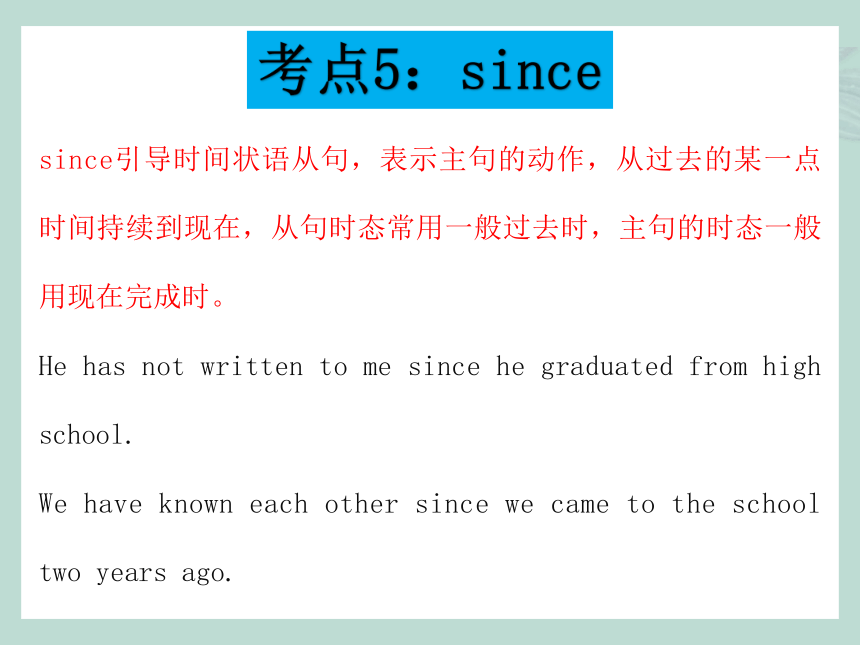


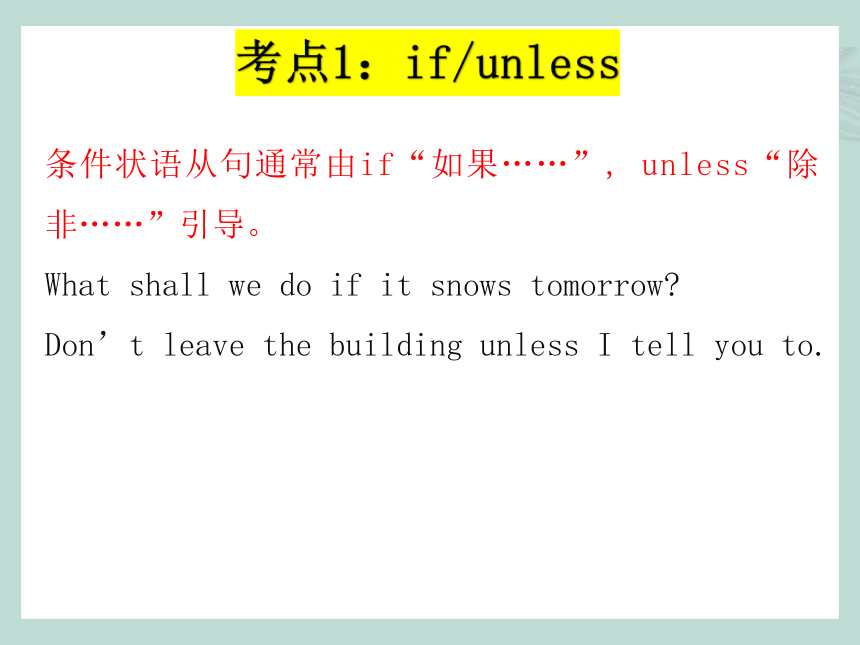
文档简介
(共33张PPT)
状语从句
状语从句指用作状语,起副词作用的从句。
时间状语从句 地点状语从句 条件状语从句原因状语从句 结果状语从句 比较状语从句目的状语从句 让步状语从句 方式状语从句
考点1:when, as和while
① when, as和while引导时间状语从句均表示“当……时候”。
It was raining hard when I got to school yesterday.
While he was doing his homework, the telephone rang.
As he walked along the lake, he sang happily.
② 时间状语从句引导词while, when和as的区别。
◆ when既可以指“时间点”,与瞬间动词连用,也可以指“时间段”,与延续性动词连用(=while)。
◆ while表示时间段,因此,while从句的谓语动词要用延续性动词。另外while还可以表示对比。
◆ as与when用法相似,但着重强调主句动作与从句动作同时发生,有“随着……”或“一边……一边……”之意。
考点2:before和after
before“在……之前”和after“在……之后”引导的时间状语从句。
He had learned a little Chinese before he came to China.
After he had finished middle school, he went to work in a factory.
考点3:until和till
在带有till或until引导的时间状语从句的主从复合句里,如果主句用肯定式,其含义是“一直到……时”,谓语动词只能用延续性动词。如果主句用否定式,其含义是“直到……才……”, “在……以前不……”, 谓语动词可用瞬间动词。
The young man read till the light went out.
Let’s wait until the rain stops.
We won’t start until Bob comes.
Don’t get off until the bus stops.
考点4:as soon as
as soon as“一……就……”引导的时间状语从句。
As soon as I arrive, I will call you.
He will be happy as soon as he thinks of his childhood.
考点5:since
since引导时间状语从句,表示主句的动作,从过去的某一点时间持续到现在,从句时态常用一般过去时,主句的时态一般用现在完成时。
He has not written to me since he graduated from high school.
We have known each other since we came to the school two years ago.
考点6:主将从现问题
在时间状语从句里,通常不用将来时态,用现在时态表示将来的动作或状态。
I’ll ring you up as soon as I get to New York.
I will tell him everything when he comes back.
He won’t believe it until he sees it with his own eyes.
考点1:if/unless
条件状语从句通常由if“如果……”, unless“除非……”引导。
What shall we do if it snows tomorrow
Don’t leave the building unless I tell you to.
考点2:主将从现
在条件状语从句里,谓语动词通常用现在时态表示将来的动作或状态。
I’ll help you with your English if I am free tomorrow.
He won’t be late unless he is ill.
“祈使句 + and (or)+ 陈述句”在意思上相当于一个带有条件状语从句的复合句。
Hurry up, or you’ll be late.
=If you don’t hurry up, you’ll be late.
Study hard and you will pass the exam.
=If you study hard, you will pass the exam.
考点1:where引导状语从句
Go where you like.
Where there is a will, there is a way.
考点1:because, since, as和for
He didn’t come to school because he was ill.
As it is raining, we shall not go the zoo.
Since you can’t answer the question, I’ll ask someone else.
He could not have seen me, for I was not there.
考点2:because, as, since和for 的区别
because用于表示直接原因,回答why提出的问题,语气最强;as用于说明原因, 着重点在主句,常译成“由于”;since表示显然的或已知的理由或事实,常译成“既然”;for表示原因时,只能放在主句之后,起到补充说明的作用。
---Why didn’t you go there
---Because I didn’t want to.
Water is very important because we can't live without it.
He didn't come yesterday as his mother was ill.
I'll do it for you since you are busy.
考点1:so…that和such…that
He is so poor that he can’t buy a bike for his son.
She is such a good teacher that everybody likes her.
考点2:so…that与such...that可以互换
① 在so...that引导的结果状语从句中,so是副词,与形容词连用。其结构是: “...so + 形容词(副词)+ that + 从句”。
② 在such…that引导的结果状语从句中,such是形容词,它修饰名词。其结构是: “...such + a/an+形容词+可数名词单数+ that + 从句”、“...such +形容词+可数名词复数+ that + 从句”和“...such +形容词+不可数名词+ that + 从句”。
He was so glad that he couldn’t say a word.
It was such a hot day that nobody wanted to do anything.
考点1:so that和in order that
We started early so that we could catch the first train.
He studies hard so that he could find a good job in the future.
We used the computer in order that we might save time.
考点1:though和although
though和although引导让步状语从句表示“虽然,纵然”之意。这两个连词意思大致相同,在一般情况下可以互换使用。
My will remain firm though I must lower my physical sights.
Although/Though he was exhausted,(still) he kept on working.
考点2:even though和even if
even if和even though 引导让步状语从句表示“即使……”,“纵使……”之意。
We’ll make a trip even if/though the weather is bad.
Even if he is poor,she loves him.
比较状语从句通常由as…as, 比较级 + than…等连词引导。
Tom runs faster than John does.
This classroom is as big as that one.
as或(just) as引导的方式状语从句通常位于主句后,意思是“正如…”,“就像”。
Always do to the others as you would be done by.
As water is to fish, so air is to man.
as if和as though引导方式状语从句,意为"仿佛……似的","好像……似的"。
They completely ignore these facts as if (as though) they never existed.
He looks as if (as though) he had been hit by lighting.
THANK YOU
状语从句
状语从句指用作状语,起副词作用的从句。
时间状语从句 地点状语从句 条件状语从句原因状语从句 结果状语从句 比较状语从句目的状语从句 让步状语从句 方式状语从句
考点1:when, as和while
① when, as和while引导时间状语从句均表示“当……时候”。
It was raining hard when I got to school yesterday.
While he was doing his homework, the telephone rang.
As he walked along the lake, he sang happily.
② 时间状语从句引导词while, when和as的区别。
◆ when既可以指“时间点”,与瞬间动词连用,也可以指“时间段”,与延续性动词连用(=while)。
◆ while表示时间段,因此,while从句的谓语动词要用延续性动词。另外while还可以表示对比。
◆ as与when用法相似,但着重强调主句动作与从句动作同时发生,有“随着……”或“一边……一边……”之意。
考点2:before和after
before“在……之前”和after“在……之后”引导的时间状语从句。
He had learned a little Chinese before he came to China.
After he had finished middle school, he went to work in a factory.
考点3:until和till
在带有till或until引导的时间状语从句的主从复合句里,如果主句用肯定式,其含义是“一直到……时”,谓语动词只能用延续性动词。如果主句用否定式,其含义是“直到……才……”, “在……以前不……”, 谓语动词可用瞬间动词。
The young man read till the light went out.
Let’s wait until the rain stops.
We won’t start until Bob comes.
Don’t get off until the bus stops.
考点4:as soon as
as soon as“一……就……”引导的时间状语从句。
As soon as I arrive, I will call you.
He will be happy as soon as he thinks of his childhood.
考点5:since
since引导时间状语从句,表示主句的动作,从过去的某一点时间持续到现在,从句时态常用一般过去时,主句的时态一般用现在完成时。
He has not written to me since he graduated from high school.
We have known each other since we came to the school two years ago.
考点6:主将从现问题
在时间状语从句里,通常不用将来时态,用现在时态表示将来的动作或状态。
I’ll ring you up as soon as I get to New York.
I will tell him everything when he comes back.
He won’t believe it until he sees it with his own eyes.
考点1:if/unless
条件状语从句通常由if“如果……”, unless“除非……”引导。
What shall we do if it snows tomorrow
Don’t leave the building unless I tell you to.
考点2:主将从现
在条件状语从句里,谓语动词通常用现在时态表示将来的动作或状态。
I’ll help you with your English if I am free tomorrow.
He won’t be late unless he is ill.
“祈使句 + and (or)+ 陈述句”在意思上相当于一个带有条件状语从句的复合句。
Hurry up, or you’ll be late.
=If you don’t hurry up, you’ll be late.
Study hard and you will pass the exam.
=If you study hard, you will pass the exam.
考点1:where引导状语从句
Go where you like.
Where there is a will, there is a way.
考点1:because, since, as和for
He didn’t come to school because he was ill.
As it is raining, we shall not go the zoo.
Since you can’t answer the question, I’ll ask someone else.
He could not have seen me, for I was not there.
考点2:because, as, since和for 的区别
because用于表示直接原因,回答why提出的问题,语气最强;as用于说明原因, 着重点在主句,常译成“由于”;since表示显然的或已知的理由或事实,常译成“既然”;for表示原因时,只能放在主句之后,起到补充说明的作用。
---Why didn’t you go there
---Because I didn’t want to.
Water is very important because we can't live without it.
He didn't come yesterday as his mother was ill.
I'll do it for you since you are busy.
考点1:so…that和such…that
He is so poor that he can’t buy a bike for his son.
She is such a good teacher that everybody likes her.
考点2:so…that与such...that可以互换
① 在so...that引导的结果状语从句中,so是副词,与形容词连用。其结构是: “...so + 形容词(副词)+ that + 从句”。
② 在such…that引导的结果状语从句中,such是形容词,它修饰名词。其结构是: “...such + a/an+形容词+可数名词单数+ that + 从句”、“...such +形容词+可数名词复数+ that + 从句”和“...such +形容词+不可数名词+ that + 从句”。
He was so glad that he couldn’t say a word.
It was such a hot day that nobody wanted to do anything.
考点1:so that和in order that
We started early so that we could catch the first train.
He studies hard so that he could find a good job in the future.
We used the computer in order that we might save time.
考点1:though和although
though和although引导让步状语从句表示“虽然,纵然”之意。这两个连词意思大致相同,在一般情况下可以互换使用。
My will remain firm though I must lower my physical sights.
Although/Though he was exhausted,(still) he kept on working.
考点2:even though和even if
even if和even though 引导让步状语从句表示“即使……”,“纵使……”之意。
We’ll make a trip even if/though the weather is bad.
Even if he is poor,she loves him.
比较状语从句通常由as…as, 比较级 + than…等连词引导。
Tom runs faster than John does.
This classroom is as big as that one.
as或(just) as引导的方式状语从句通常位于主句后,意思是“正如…”,“就像”。
Always do to the others as you would be done by.
As water is to fish, so air is to man.
as if和as though引导方式状语从句,意为"仿佛……似的","好像……似的"。
They completely ignore these facts as if (as though) they never existed.
He looks as if (as though) he had been hit by lighting.
THANK YOU
同课章节目录
- 词法
- 名词
- 动词和动词短语
- 动词语态
- 动词时态
- 助动词和情态动词
- 非谓语动词
- 冠词
- 代词
- 数词和量词
- 形容词副词及其比较等级
- 介词和介词短语
- 连词和感叹词
- 构词法
- 相似、相近词比较
- 句法
- 陈述句
- 一般疑问句和否定疑问句
- 特殊疑问句及选择疑问句
- 反意疑问句
- 存在句(There be句型)
- 宾语从句
- 定语从句
- 状语从句
- 主谓一致问题
- 简单句
- 并列句
- 复合句
- 主谓一致
- 主、表语从句
- 名词性从句
- 直接引语和间接引语
- 虚拟语气
- 感叹句
- 强调句
- 倒装句
- 祈使句
- 句子的成分
- 句子的分类
- 题型专区
- 单项选择部分
- 易错题
- 完形填空
- 阅读理解
- 词汇练习
- 听说训练
- 句型转换
- 补全对话
- 短文改错
- 翻译
- 书面表达
- 任务型阅读
- 语法填空
- 其他资料
